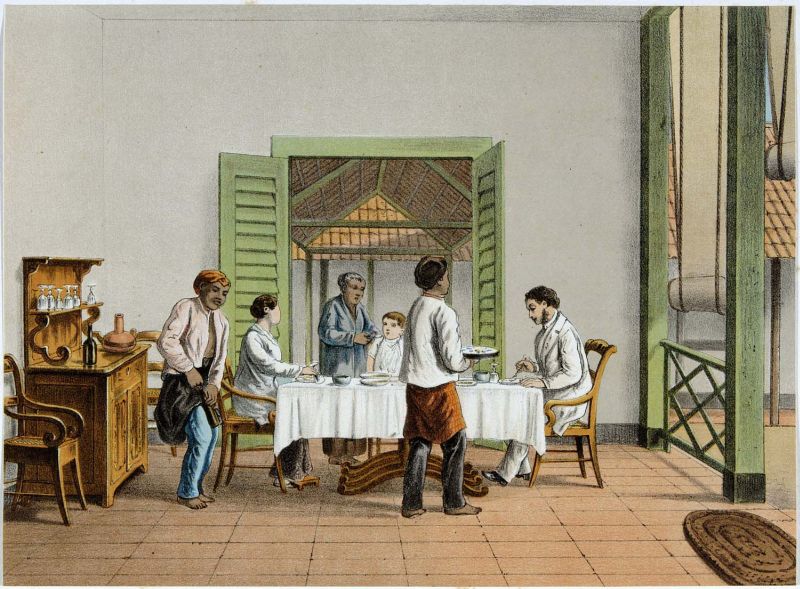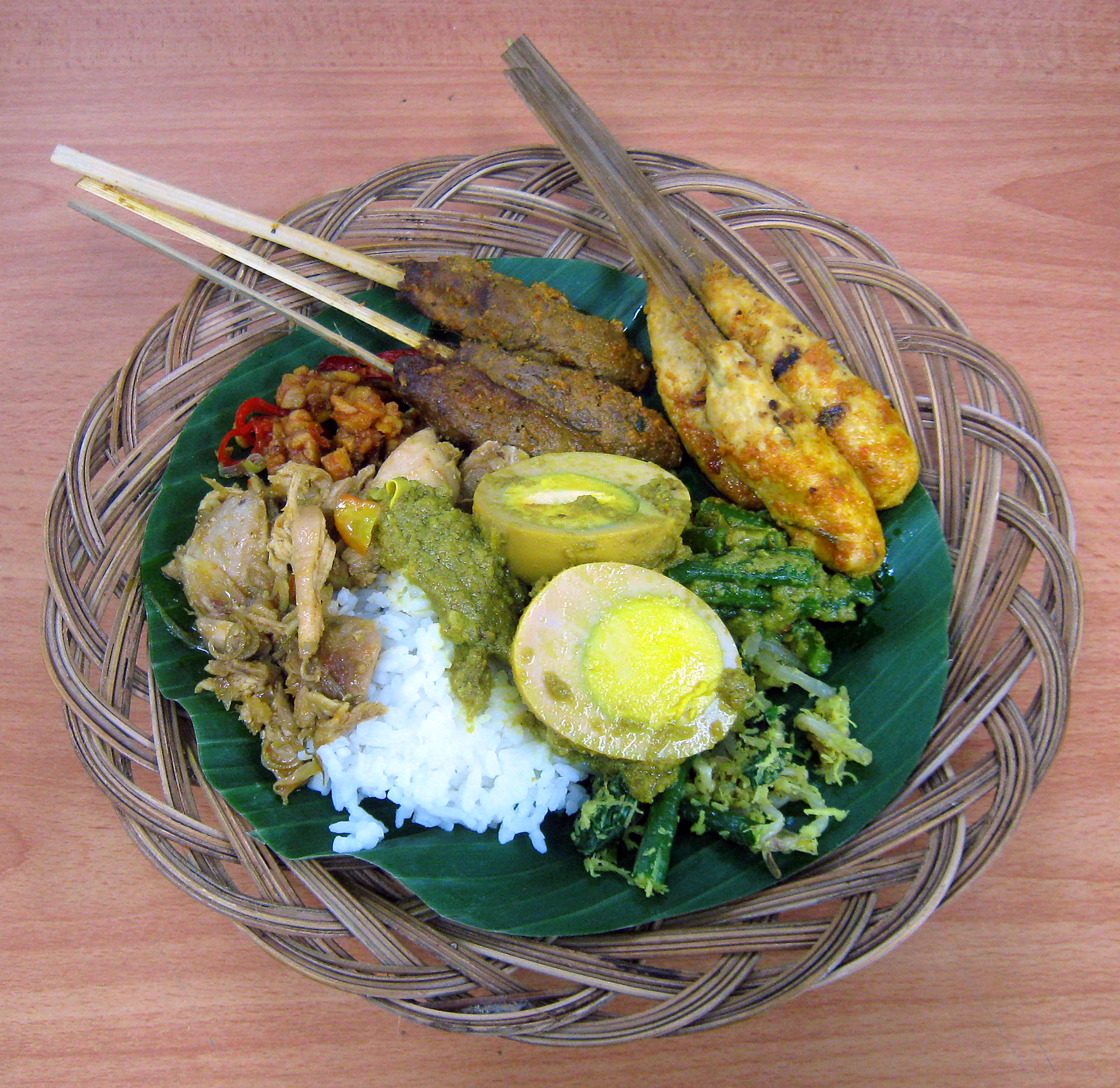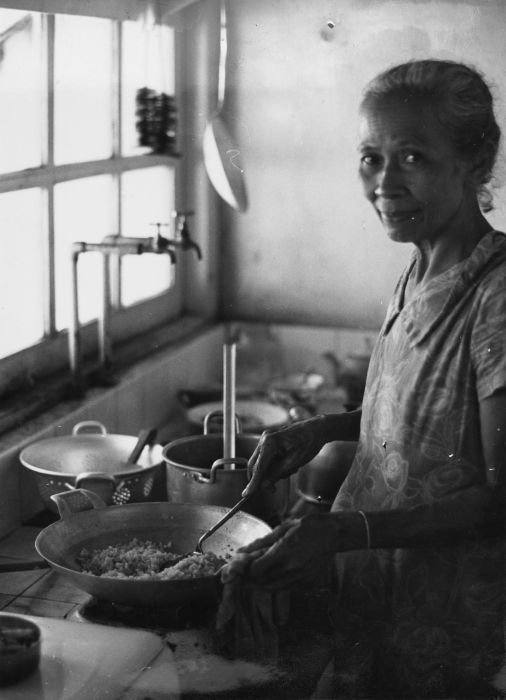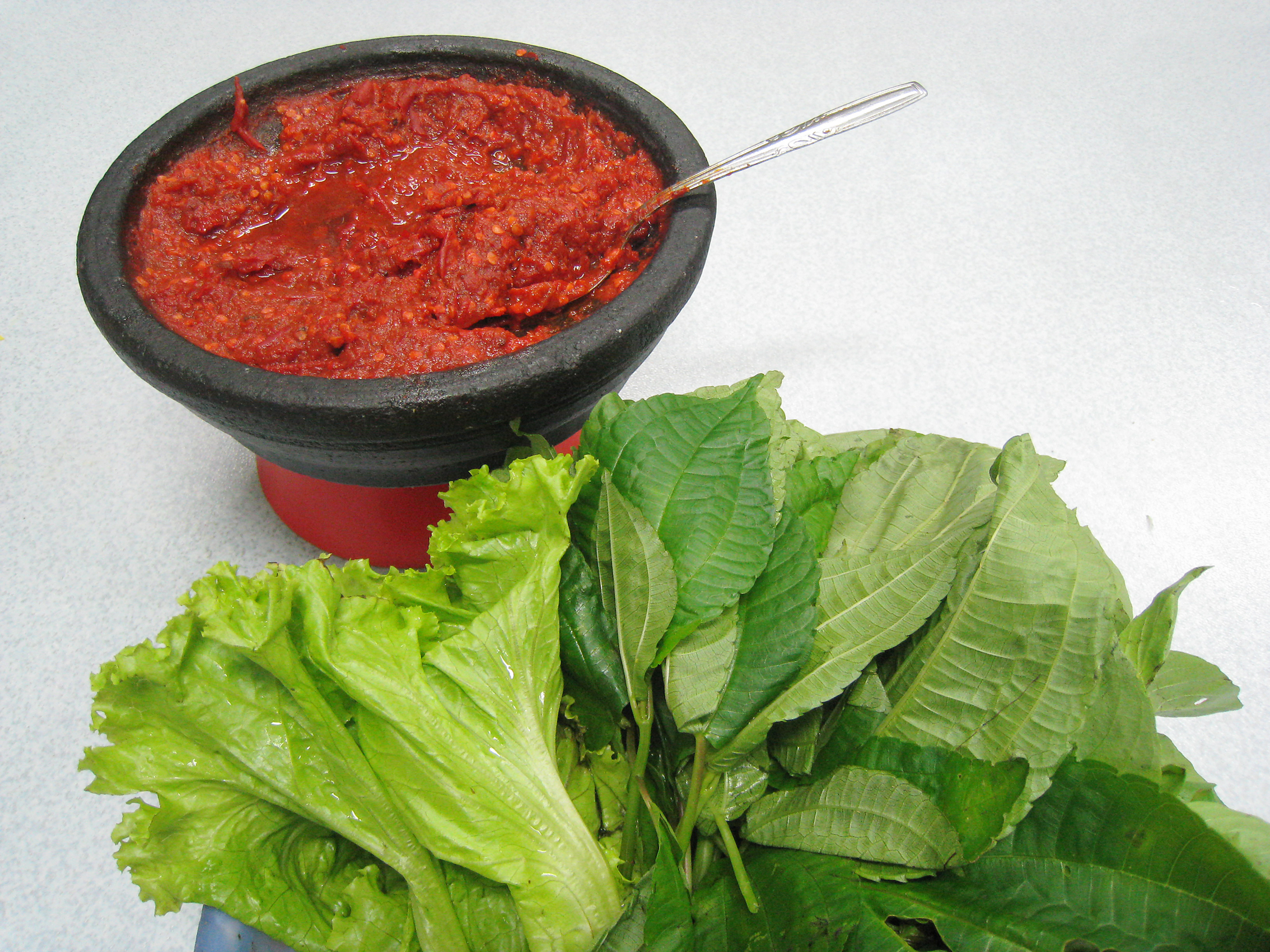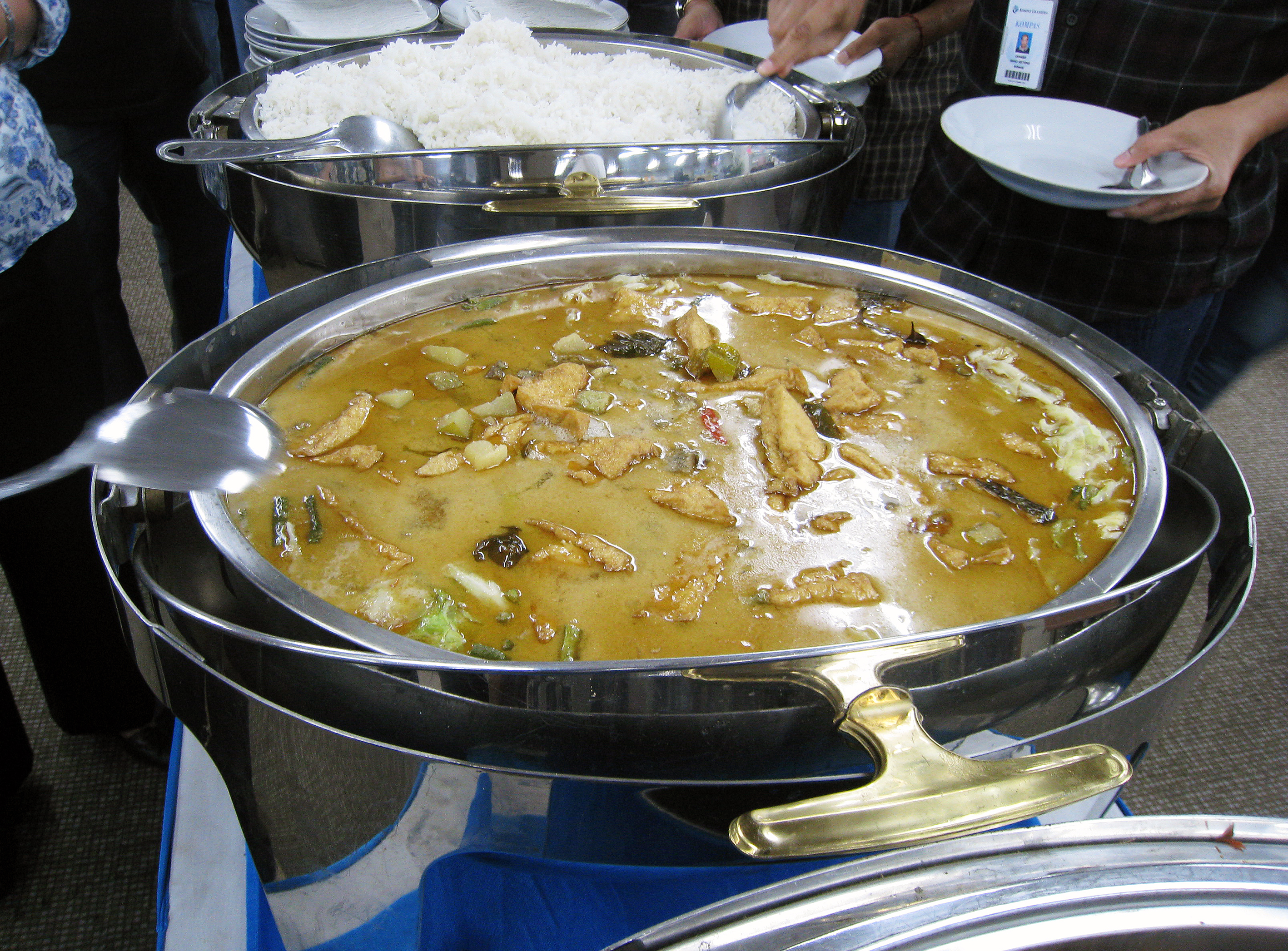|
Rijsttafel
( , ), a Dutch word that literally translates to "rice table", is an Indonesian elaborate meal adapted by the Dutch following the ''hidang'' presentation of ''nasi padang'' from the Padang region of West Sumatra. It consists of many (forty is not an unusual number) side dishes served in small portions, accompanied by rice prepared in several different ways. Popular side dishes include egg rolls, sambals, satay, fish, fruit, vegetables, pickles, and nuts. In most areas where it is served, such as the Netherlands, and other areas of strong Dutch influence (such as parts of the West Indies), it is known under its Dutch name. Although the dishes served are undoubtedly Indonesian, the ''rijsttafel''’s origins were colonial. The Dutch introduced the rice table not only so they could enjoy a wide array of dishes at a single sitting but also to impress visitors with the exotic abundance of their colony. ''Rijsttafels'' strive to feature an array of not only flavors and colors and ... [...More Info...] [...Related Items...] OR: [Wikipedia] [Google] [Baidu] |
Indonesian Cuisine
Indonesian cuisine is a collection of various regional culinary traditions that formed the archipelagic nation of Indonesia. There are a wide variety of recipes and cuisines in part because Indonesia is composed of approximately 6,000 populated islands of the total 17,508 in the world's largest archipelago,"Indonesian Cuisine." . Accessed July 2011. [...More Info...] [...Related Items...] OR: [Wikipedia] [Google] [Baidu] |
Dutch East Indies
The Dutch East Indies, also known as the Netherlands East Indies ( nl, Nederlands(ch)-Indië; ), was a Dutch colony consisting of what is now Indonesia. It was formed from the nationalised trading posts of the Dutch East India Company, which came under the administration of the Dutch government in 1800. During the 19th century, the Dutch possessions and hegemony expanded, reaching the greatest territorial extent in the early 20th century. The Dutch East Indies was one of the most valuable colonies under European rule, and contributed to Dutch global prominence in spice and cash crop trade in the 19th to early 20th centuries. The colonial social order was based on rigid racial and social structures with a Dutch elite living separate from but linked to their native subjects. The term ''Indonesia'' came into use for the geographical location after 1880. In the early 20th century, local intellectuals began developing the concept of Indonesia as a nation state, and set the stage ... [...More Info...] [...Related Items...] OR: [Wikipedia] [Google] [Baidu] |
Nasi Campur
Nasi campur (Indonesian for 'mixed rice'), also known as nasi rames or sega campur (; ) in Java, refers to an Indonesian dish of a scoop of ''nasi putih'' (white rice) accompanied by small portions of a number of other dishes, which includes meats, vegetables, peanuts, eggs, and fried-shrimp krupuk. Depending on origin, a nasi campur vendor might serve several side dishes, including vegetables, fish, and meats. It is a staple meal from Indonesia and popular in Malaysia, Singapore, Brunei, and southern Thailand, and also the Netherlands through its colonial ties with Indonesia. A similar form called ''chanpurū'' exists in Okinawa. Origin and variations Nasi campur is a ubiquitous dish around Indonesia and as diverse as the Indonesian archipelago itself, with regional variations. There is no exact rule, recipe, or definition of what makes a nasi campur, since Indonesians and by large Southeast Asians commonly consume steamed rice surrounded with side dishes consisting of vegetabl ... [...More Info...] [...Related Items...] OR: [Wikipedia] [Google] [Baidu] |
Rendang
Rendang ( ; ) is a Minang dish originating from the Minangkabau region in West Sumatra, Indonesia. It has spread across Indonesian cuisine to the cuisines of neighbouring Southeast Asian countries such as Malaysia, Singapore, Brunei and the Philippines. Rendang is often described as a rich dish of meat — most commonly beef (''rendang daging'') — that has been slow cooked and braised in a coconut milk seasoned with a herb and spice mixture, until the liquids evaporate and the meat turns dark brown and tender, becoming caramelized and infused with rich flavours. As the signature dish of Minangkabau culture, rendang is traditionally served at ceremonial occasions to honour guests during festive events; such as wedding feasts and ''Lebaran'' or ''Hari Raya'' (Indonesian popular words for both Eid al-Fitr and Eid al-Adha). Rendang is also traditionally served among the Malay community in Indonesia, Malaysia, Singapore and Brunei, as well as the Maranao in the Philippin ... [...More Info...] [...Related Items...] OR: [Wikipedia] [Google] [Baidu] |
The Hague
The Hague ( ; nl, Den Haag or ) is a city and municipality of the Netherlands, situated on the west coast facing the North Sea. The Hague is the country's administrative centre and its seat of government, and while the official capital of the Netherlands is Amsterdam, The Hague has been described as the country's de facto capital. The Hague is also the capital of the province of South Holland, and the city hosts both the International Court of Justice and the International Criminal Court. With a population of over half a million, it is the third-largest city in the Netherlands, after Amsterdam and Rotterdam. The Hague is the core municipality of the Greater The Hague urban area, which comprises the city itself and its suburban municipalities, containing over 800,000 people, making it the third-largest urban area in the Netherlands, again after the urban areas of Amsterdam and Rotterdam. The Rotterdam–The Hague metropolitan area, with a population of approximately 2.6&n ... [...More Info...] [...Related Items...] OR: [Wikipedia] [Google] [Baidu] |
Soto Ayam
Soto ayam is a traditional Indonesian dish which uses ingredients such as chicken, ''lontong'', noodles, and rice vermicelli. Soto ayam is popular in Singapore, Malaysia and Suriname. Turmeric is added as one of its main ingredients which makes the yellow chicken broth. It is one of the most popular variant of '' soto'', a traditional soup commonly found in Indonesian cuisine. Besides chicken and vermicelli, it can also be served with hard-boiled eggs, slices of fried potatoes and Chinese celery leaves. Fried shallots are usually added as garnish. Coconut milk (''santan'') is also used as an additional ingredient. ''Koya'', a powder of mixed prawn crackers with fried garlic, or sambal is a common topping. ''Krupuk'' or '' emping'' is also a common topping. Lalapan is usually served as a side dish. Variations Different regions have their own variation of this dish, for instance: * Soto Ambengan, originated from Ambengan, Surabaya. Soto Ambengan is famous for its ''koya'' topping ... [...More Info...] [...Related Items...] OR: [Wikipedia] [Google] [Baidu] |
Nasi Goreng
''Nasi goreng'' (English pronunciation: ) is a Southeast Asian fried rice dish, usually cooked with pieces of meat and vegetables. One of Indonesia's national dishes, it is also eaten in Malay-speaking communities in countries such as Malaysia, Singapore and Brunei, and has gained popularity in Sri Lanka through migrations from the Malay Archipelago, in countries like Suriname via Indonesian immigrant communities, and in the Netherlands through its colonial ties with Indonesia. ''Nasi goreng'' is distinguished from other Asian fried rice preparations by its distinct smoky aroma, and caramelised yet savoury undertones of flavour. There is no single defined recipe for ''nasi goreng'', and its composition and preparation varies greatly from household to household. ''Nasi goreng'' has long been considered an important staple of Indonesian cuisine. In 2018, it is officially recognized by the Indonesian government as one of the country's five national dishes. A ubiquitous meal thr ... [...More Info...] [...Related Items...] OR: [Wikipedia] [Google] [Baidu] |
Gulai
''Gulai'' is a class of spicy and rich stew commonly found in Indonesia, Malaysia and Singapore. The main ingredients of this dish are usually poultry, goat meat, beef, mutton, various kinds of offal, fish and seafood, as well as vegetables such as cassava leaves, unripe jackfruit and banana stem. ''Gulai'' is often described as Indonesian curry, although it is also considered a local dish in Malaysia and Singapore. Gulai is a common name to refer to curry dishes in the country, although Indonesian, Malaysian, and Singaporean cuisine also recognise ''kari'' (curry). Ingredients The ''gulai'' sauces commonly have a thick consistency with a yellowish colour because of the addition of ground turmeric. Gulai sauce ingredients consist of rich spices such as turmeric, coriander, black pepper, galangal, ginger, chilli pepper, shallot, garlic, fennel, lemongrass, cinnamon and caraway, ground into paste and cooked in coconut milk with the main ingredients. In Malaysia, kerisik is als ... [...More Info...] [...Related Items...] OR: [Wikipedia] [Google] [Baidu] |
Priangan
Parahyangan ( su, ᮕᮛᮠᮡᮀᮠᮔ᮪; Bantenese: Priangan; Dutch: Preanger) is a cultural and mountainous region in West Java province on the Indonesian island of Java. Covering a little less than one sixth of Java, it is the heartland of Sundanese people and their culture. It is bordered to the West by Banten province, to the North by the northern coast region of Subang, Cirebon and Indramayu (former residencies of Batavia and Cheribon), to the east by Central Java province (former residencies of Banyumas and Pekalongan), and to the south by the Indian Ocean. Etymology The name "Parahyangan" has its origins from Sundanese words that mean "the abode of hyangs (gods)". Parahyangan is a mountainous region, and ancient Indonesians believed that the gods resided in the mountain tops. A Sundanese legend of Sangkuriang contains the memory of the prehistoric ancient lake in Bandung basin highland, which suggests that the Sundanese had already inhabited the region since the ... [...More Info...] [...Related Items...] OR: [Wikipedia] [Google] [Baidu] |
Jakarta
Jakarta (; , bew, Jakarte), officially the Special Capital Region of Jakarta ( id, Daerah Khusus Ibukota Jakarta) is the capital and largest city of Indonesia. Lying on the northwest coast of Java, the world's most populous island, Jakarta is the largest city in Southeast Asia and serves as the diplomatic capital of ASEAN. The city is the economic, cultural, and political centre of Indonesia. It possesses a province-level status and has a population of 10,609,681 as of mid 2021.Badan Pusat Statistik, Jakarta, 2022. Although Jakarta extends over only , and thus has the smallest area of any Indonesian province, its metropolitan area covers , which includes the satellite cities Bogor, Depok, Tangerang, South Tangerang, and Bekasi, and has an estimated population of 35 million , making it the largest urban area in Indonesia and the second-largest in the world (after Tokyo). Jakarta ranks first among the Indonesian provinces in human development index. Jakarta's busin ... [...More Info...] [...Related Items...] OR: [Wikipedia] [Google] [Baidu] |
Lalab
''Lalab'' (Sundanese: , ''Lalab'') or ''lalap/lalapan'' (Indonesian) is a Sundanese raw vegetable salad served with ''sambal terasi''. It is a popular Sundanese vegetable dish originated from West Java & Banten, Indonesia. There are no set rules on what vegetables make into lalab, in practice all edible vegetables can be made as lalab. However, the most common raw vegetables are cucumber, tomato, cabbage, lettuce, lemon basil, ''leunca'' and long beans. While blanched or boiled vegetables include spinach, papaya leaves and chayote. The dressing for this salad usually is ''sambal terasi'' served directly from the stone mortar as a spicy dipping sauce for these assorted raw vegetables. Today, ''lalab'' is popular throughout Indonesia. It is usually served as vegetable side dish next to the main course, such as ''ayam goreng'' (fried chicken), ''ayam bakar'' (grilled chicken), ''pepes'', '' pecel lele'' (fried catfish), fried gourami, and many other ''ikan goreng'' (fried fis ... [...More Info...] [...Related Items...] OR: [Wikipedia] [Google] [Baidu] |
Sayur Lodeh
Sayur lodeh is an Indonesian vegetable soup prepared from vegetables in coconut milk popular in Indonesia, but most often associated with Javanese cuisine. Ingredients Common ingredients are young unripe jackfruit, eggplant, chayote, ''melinjo'' beans and leaves, long beans, green chili pepper, tofu and tempeh, cooked in coconut milk and sometimes enriched with chicken or beef stock. The ''bumbu'' spice mixture includes ground chili pepper (optional, depending on the desired degree of spiciness), shallot, garlic, candlenut, coriander, ''kencur'' powder, turmeric powder (optional), dried shrimp paste, salt and sugar. There are two main variants of sayur lodeh soup based on its colour; the white and yellow lodeh. The greenish white sayur lodeh is made without turmeric, while the golden yellow one has turmeric in it. Sometimes green stink beans are added. The ingredients of sayur lodeh are similar to sayur asem, with the main difference in its liquid portion, sayur lodeh is coconu ... [...More Info...] [...Related Items...] OR: [Wikipedia] [Google] [Baidu] |
